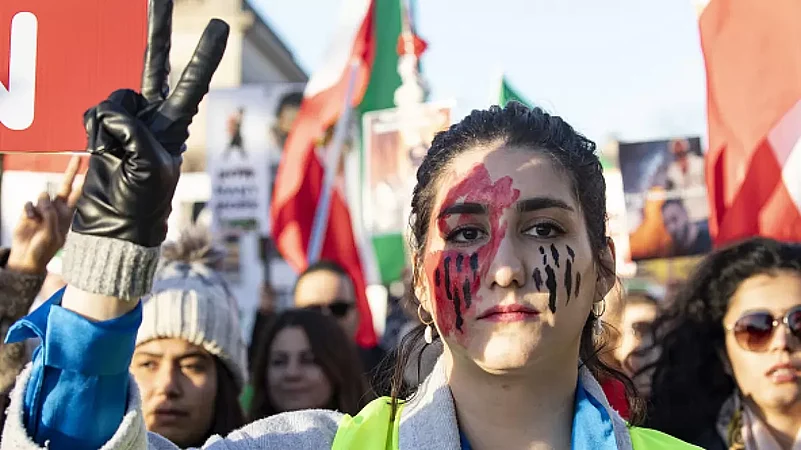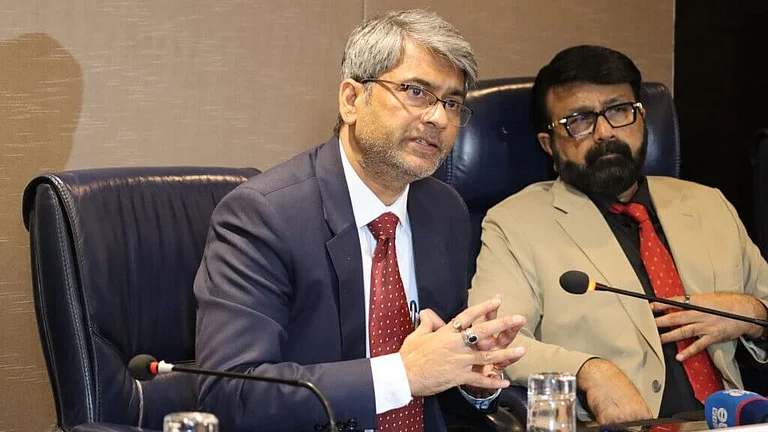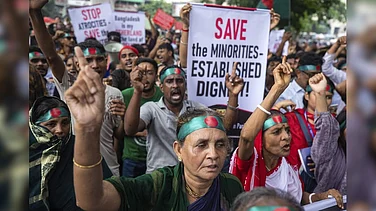The protests in Iran sparked off by the death of a 22-year-old woman, Masha Amini, in police custody for violating the hijab-law in September, is fast getting caught in the geo-politics of the region.
The Iranian football team’s daring act of refusing to sing the national anthem at the FIFA World Cup in Qatar, successfully brought international attention to the protest at home.
But their 6-2 drubbing in the game against England made Iranian newspapers accuse the foreign enemies- the United States, Britain, Israel, and Saudi Arabia-- of stirring up protests to throw the national team off its game.
The attempt of pitting the performance of the Iranian footballers in Qatar against a foreign conspiracy is a deliberate ploy on Teheran’s part. Its attempt is to stem the growing support for the protesters at home.
In the run-up to the FIFA World Cup, Iran’s national team came under enormous pressure from protesters to show support. The players faced a barrage of public criticism after meeting President Ebrahim Raisi at a send-off ceremony, where they were silent on the issue of protests.
“So you went to the president, that was the best opportunity to ask him not to kill kids and teenagers, at the very least!” Parviz Parastouei, a prominent Iranian actor wrote on Instagram.
Amini’s death has seen one of the largest and most sustained protests in the Islamic Republic since it was established in 1979.
But despite the harsh crackdown by the Iranian authorities, the protestors have not been deterred. Adopting the Kurdish slogan “woman, life, freedom” as their rallying cry, they have taken to the streets to demand political freedom, defying internet blackouts, mass arrests, and live-fire attacks by security forces.
More than 400 protestors have been killed and scores injured since Amini ‘s death and another 15,000 demonstrators have been taken into custody.
Several of them have also been tried in court and sentenced to death for waging a war against God—as the Iranian government has framed the protests.
But even before the current protests began, Iran has been facing a series of challenges like widening frustration over social restrictions, outrage over economic collapse and mismanagement, and rising anger and frustration against the Islamic regime.
The anti-hijab protesters had begun with calls to abolish the religious police. But now they have turned into full-throated attacks on the clerical establishment and the 83-year-old Supreme leader, Ayatollah Ali Khamenei.
However, as the country-wide women’s protest began to converge into a crisis of legitimacy for the Islamic Republic, the Iranian authorities have started to point towards the foreign enemy that is conspiring to disintegrate the country.
The ongoing protests have evoked strong response from the US, the European Union, the UK, and Canada who have imposed a slew of human rights sanctions against Iranian officials and entities.
Recently on the initiative of Germany and Iceland, a special session of the United Nations Human Rights Council was held to discuss the situation in Iran, and a fact-finding team has now been formed to investigate abuses committed during the crackdown on the protestors.
A group of UN experts has also called on Iran to stop sentencing people to death for participating in the protests.
In addition, Iranians outside the country have also held several protests in different countries against the repressive measures used by Iran against the protesters.
But the widespread support from outside have come in handy for Teheran to project the protests at home as being engineered by the US and Israel to destabilise the Islamic Republic.
Iranians who were unhappy with the regime for being indifferent to the hardship they were facing for years and were supportive of the women protesters, have now begun to doubt the forces driving the protests at home.
This has allowed Teheran to use more coercive measures through the Islamic Revolutionary Guards Corps and the Basij paramilitary against the protesters. It has also activated its network of mosques and socio-cultural institutions, to launch a relentless propaganda against the outside forces who were active in creating unrest in Iran to bring a regime change.
At the global level, Iran has moved closer to China and Russia, as all three have faced sanctions and isolation initiated by America and its allies in the region and beyond in recent years.
Iran feels confident that if the western countries use the pretext of the ongoing protests to intensify their effort to isolate Teheran further, China and Russia, both veto-wielding members of the UN Security Council, will come to its support.
India, a strategic partner of Iran, has watched the developments in Teheran closely but refrained from reacting officially.
This has not stopped Indians from supporting the Iranian women’s protest. But ironically, it coincided with the protests that began in Karnataka for wearing the hijab. Many accused supporters in India for the Iranian women’s right as maintaining double-standards as they adopted a different approach when it came to Indian women and their rights.
But India’s decision not to comment on developments in Iran falls within its stated policy of refraining from making comments on internal affairs of other countries.
Moreover, Iran is a major source for India ‘s energy needs and key to its access to Afghanistan through the Chabahar port. Both countries have also been working closely in facing the challenges in Afghanistan and elsewhere in the region.
But the women’s protest comes at a time when the Iranian clerics are busy looking for a suitable successor for the Supreme Leader, who has been keeping indifferent health for some time.
Observers feel the competition to succeed him to intensify in the coming days. Irrespective of the outcome, the transition will have far reaching consequences for Iran’s relationship with its Arab neighbours and western adversaries.
Iran’s president Ebrahim Raisi has often been seen as a leading contender to replace Khamenei.
But his chances could be seriously jeopardised, if he fails to bring an early and effective end to the protests that have been rocking Iran for the past three months.


























